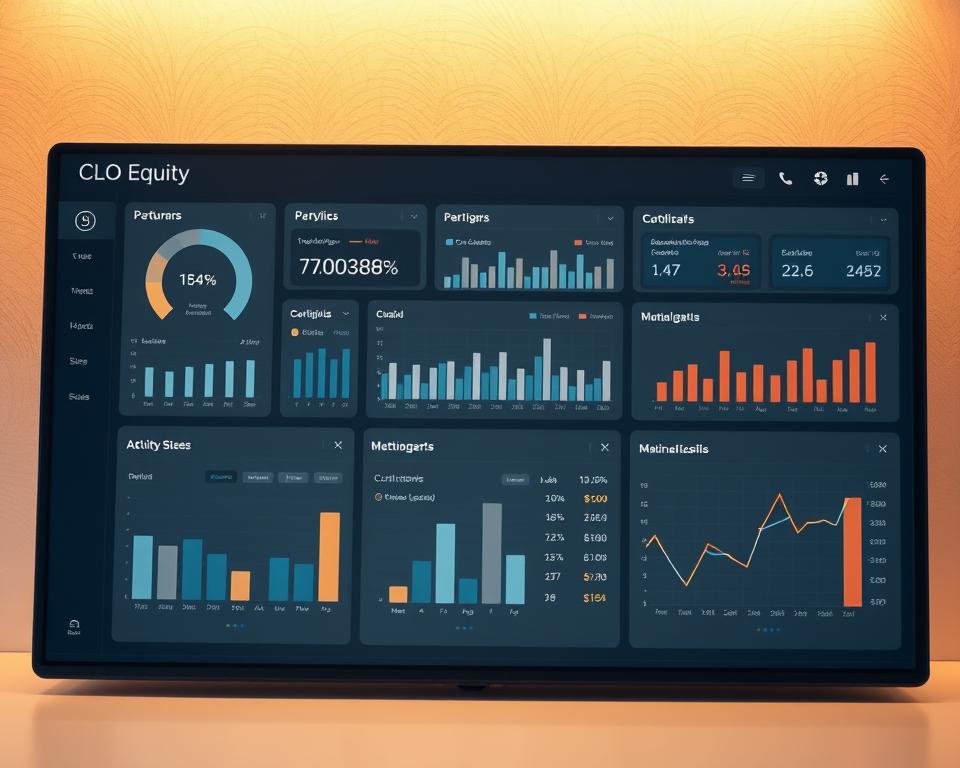Monitor One’s CLO Share Operation Efficiently
Have you discovered that CLOs in the U.S. have expanded into an immense $1.1 trillion sector? This growth isn’t just related solely to statistics. It signifies the financial market’s complexity and CLO capital’s budding position for participants such as major pension funds and private wealth offices. The rise of sophisticated investors in CLOs emphasizes the significance of commanding CLO equity performance monitoring.
Allocating funds to CLO equity investments presents many benefits, appealing to a broad spectrum of stakeholders. The possibility of significant gains and consistent cash payouts makes CLO funds a valuable addition to diverse portfolios. This distinctive offering highlights their allure. Investors are captivated by CLO equity for its profit capacity, often aiming for mid-teens returns, akin to private equity’s typical returns. This charm endures, in spite of shifting interest rates and economic shifts. CLOs, with their 150-200 diverse holdings, offer a degree of security rare in concentrated portfolios. I intend to supply you with the essential indicators and perspectives for equity CLO results, assisting in making prudent investment choices.
Understanding CLOs: A Exhaustive Outline
Collateralized loan obligations (CLOs) are intricate fiscal instruments. They aggregate diverse leveraged loans, dividing them to investors. Grasping CLOs is crucial as they supply corporate financing solutions. Over three and a half decades, their progress has profoundly changed capital strategies for organizations. This part provides insight into the CLO market’s historical evolution and current trends. It highlights key trends and characteristics affecting stakeholders.
What exactly is a CLO?
CLOs offer a innovative method for managing borrowed funds. They amalgamate more than 200 below-investment-grade, well-secured corporate loans. This strategy aims to minimize risk while producing attractive yields. The U.S. CLO market has been thriving, now surpassing $1 trillion as of March 2024. Since 2012, it’s grown roughly 10% yearly. Despite a slowdown in growth to about 6% in 2023, a small decrease to 1% is foreseen in early 2024. Notably, the prime segments, AAA and AA, have maintained default-free status, underscoring CLOs’ stability.
CLO Growth and Evolution Through the Years
The evolution of CLOs is notably marked by their robustness during financial slumps. The recent financial upheaval confirmed this resilience; CLOs maintained strong credit standing with low default rates, unlike corporate bonds. Following a decline to $263 billion in the post-crisis period, the market bounced back impressively. By September 2023, it reached $970 billion. This growth showcases their trustworthiness amidst current CLO market dynamics.
Emerging strategies, like CLO ETFs, have propelled the market even further. It’s now worth $15 billion, due to increased trading and liquidity. In the America, a recent CLO deal averages around $500 million. Europe sees slightly smaller deals, normally €400 million. The majority, 60%-65%, goes to senior tiers. Equity tranches comprise about 9%-10%.
From grasping CLO fundamentals to understanding their development and modern trends, it’s clear they’re vital in capital markets. They exceptionally balance risk against return for participants.
The Attractiveness of CLO Share Investments
Investing in CLO capital investments provides many benefits, appealing to a broad spectrum of investors. The potential for high returns and regular cash distributions render CLO funds a valuable addition to multifaceted portfolios. This unique value proposition underscores their attractiveness.
Main Perks for Investors
CLO equity distinguishes itself for its potential double-digit returns. They are expected to generate returns in the low to mid-teens. Regular cash distributions augment the allure of CLO funds, especially for those seeking steady income. Moreover, robust market fundamentals, including low default incidences, increase confidence in these assets.
Over time, CLO capital has had lower default rates than traditional debt instruments. Despite potential financial stress in certain segments, expected default rates should remain low. During economic downturns, high loan spreads can advantage CLO investors. This allows for wise credit selection to reduce possible losses.
CLO Equity vs. Other Asset Classes
Comparing CLO share to other investments highlights its unique benefits. It offers superior liquidity than private equity vehicles without sacrificing returns. Although spread compression has occurred, CLOs offer superior yields than similarly rated debt, illustrating its appeal.
| Asset Class | Yields | Failure Rates | Ease of Conversion |
|---|---|---|---|
| CLO Capital | Modest Double-Digits | Lower than debt instruments | Moderate; less liquid than Treasuries |
| Private Equity | Fluctuates; usually less liquid | Dependent on the market cycle | Low; often illiquid |
| Junk Bonds | Higher than Treasuries | Increased defaults relative to CLOs | Robust; very liquid |
The demand for CLOs remains strong, indicating a promising outlook for 2024. Attractive financing costs, thanks to a beneficial spread balance, boost this asset. For investors navigating the dynamic market, an insight into CLO equity can be crucial for successful strategic planning.

Monitoring CLO Equity Performance: Metrics and Tools
For those intent on optimizing gains, accurate tracking of CLO share performance is crucial in the complicated financial environment. Efficient employment of CLO key metrics significantly boosts portfolio strategies. Comprehending essential performance indicators (KPIs), like cash disbursements, net asset value (NAV), and expense ratios is critical. They provide in-depth perspectives on the operational effectiveness of CLO investments.
Essential KPIs for CLO Capital
CLO investors keep a close eye on various KPIs to accurately gauge results. Essential measures comprise:
- Internal Rate of Return (IRR): An essential measure for appraising extended profitability.
- Cash Return Ratio: Illuminates the comparison between cash disbursements and capital invested.
- Net Value of Assets (NAV): Shows the asset market value, critical for CLO valuation.
- Distribution Rate: Typically around half of the underlying assets’ cash flows.
- Default Frequencies: Typically fall between 2% and 3%, with a mean 70% recovery for defaults.
Efficient Use of Monitoring Instruments
For successful management of CLO capital positions, which account for over $600 billion globally, efficient tracking mechanisms are crucial. Companies like Flat Rock Global provide dedicated instruments for monitoring CLO equity performance. These instruments enable stakeholders to continually track their asset holdings.
These tools assist in analyzing performance metric trends and comparing against indices like the J.P. Morgan CLO Index. They also enable comparisons to comprehensive indices such as the Bloomberg Aggregate Bond Index and the ICE BofA US Corporate Index.
Making informed decisions to optimize CLO equity performance becomes achievable for investors leveraging these metrics and tools. This comprehension and proficient use open opportunities for successful CLO management strategies.
Market Trends Influencing CLO Capital Performance
Delving into the CLO mutual funds market trends needs a thorough analysis of the financial landscape and its effect on investments. Growth statistics highlight a strong market, delivering key understandings for investors. By November 2024, U.S. CLO issuances reached $191 billion, a 72% increase compared to the previous year. This underscores an escalating interest in CLOs amidst economic shifts.
Current Market Conditions
CLO issuance volume has risen to $465 billion, outdoing the peak in 2021 at $438 billion. October 2024 led in new issuances with $59 billion, and subsequently, November delivered $26 billion, placing second. The market expanded 1% since the year’s start, totaling $1.046 trillion. Additionally, the increase in private credit CLOs with a $36 billion new issuance, set a new record.
Impact of Interest Rates on CLO Equity
Escalating interest rates critically affect CLO equity, primarily because of their variable-rate structure. This makes CLO investments increasingly appealing for investors in pursuit of greater yields in a variable market. Estimates imply CLO issuances in 2025 could fall between $180 billion and $215 billion, propelled by supportive elements. Watching the default rate, which improved from 3.3% in January 2024 to 3.1% at Q1’s end, is vital for CLO stakeholders. This evolving scene offers an opportunity to optimize portfolios amidst current CLO equity market movements.
Active Management Strategies for CLO Equity
Handling CLO capital positions requires an active approach. Through strategic market navigation, CLO equity managers aim to boost returns and mitigate risks. These managers understand the complexities of the market. This understanding profoundly impacts the outcome of stakeholders’ investments.
Performance Enhancement by Managers
CLO equity managers are pivotal in enhancing portfolio output. They keep a close eye on the credit quality and pricing of loans. With this information, they seize market opportunities. Such diligence enables swift reactions to market changes, optimizing CLO payouts. The attractive default rates and low correlation with risk assets like the average US corporate 5-year cumulative default rate underscore CLOs’ investment appeal.
CLO Management Risk Mitigation Strategies
CLO equity managers use varied techniques to protect against fiscal risks. These tactics are vital for protecting investors during volatile market periods. They focus on the spread between asset returns and debt costs to maximize cash flows. The diverse internal rates of return (IRRs) in CLO equity, with highest quartiles achieving 25% and lowest quartiles sometimes below 0%, show the importance of these mitigation strategies’ significance in maintaining investment stability through market changes.
Importance of CLO Indices and Comparative Benchmarks
Grasping the function of the CLO index is essential for informed investment decisions. It acts as a barometer for CLO equity, reflecting market dynamics and guiding investor strategies. Through the analysis of these indices, we acquire profound understanding of CLO performance indicators. This helps us compare risk and trend patterns across distinct asset categories effectively.
Understanding CLO Index Performance
The CLO market’s magnitude has reached an astonishing $1.2 trillion. It now satisfies about 70% of the demand for US corporate loans. Such expansion underscores the need for reliable benchmarks. Here, CLO indices provide a pivotal function. They measure a wide range of performance indicators, allowing investors to assess how their investments fare against the market’s broader scope.
Comparative Analysis with Other Indices
Evaluating CLO performance in comparison to other indices sheds light on its positioning. Commonly, CLO equity maintains a roughly 90% debt and 10% equity structure. In terms of safety, AAA tranches demonstrate nearly zero defaults. This is in sharp contrast to the long-term average default rates of US corporations. Thus, CLOs are notable for their attractive yields and outstanding stability in fixed income.
Furthermore, CLO yield metrics frequently demonstrate a spread edge over standard bonds, especially within high-yield areas. This leads to greater potential profits for investors along with valuable diversification perks. CLOs show a lesser correlation with other high-yield bonds and equities, enabling smarter CLO market positioning and more insightful investment strategy development.
Challenges in Monitoring CLO Equity Performance
Tracking CLO share performance is notably challenging, particularly during turbulent market conditions. Investors encounter complexities due to market variability that impact investment risk assessments and opportunity identifications. These market oscillations can dramatically affect default risks and buying choices. Therefore, deploying effective strategies is essential for sustaining prime CLO performance.
Market Volatility and Its Impact
The bond market forecast suggests that fixed income investors are transitioning to dynamic management techniques. This shift seeks to better accommodate persistent market turbulence, improving returns for fixed income portfolios. We’re in an evolving credit cycle, not yet at its peak, hinting at continuous credit portfolio opportunities through 2025. High interest rates further complicate CLO monitoring, raising capital expenses for CLO equity while highlighting the necessity for prudent management.
Understanding Default Risks in CLO Investments
It’s crucial to grasp the default hazards in CLO investments for proper monitoring. Studies show that during economic downturns, CLO loan default rates could hit 3%, adversely affecting performance. The combination of elevated interest rates and reduced returns across various investment strategies adds to the complexity. Interestingly, about approximately 40% of CLO managers use advanced analytics and AI to enhance their monitoring, addressing transparency challenges and refining performance evaluations. The compounded complexity of underlying assets and persistent regulatory shifts create extra challenges for effective CLO performance management.
Forthcoming Prospects for CLO Share Investments
The arena of collateralized debt obligations is witnessing a transformation. This change heralds a future for CLO capital investments defined by potential and complexity. Examinations of market trends underscore substantial opportunities borne from shifts in supply, demand, and interest rates. A remarkable surge in 2024 new issuances, amounting to $199.8 billion signals a robust recovery. This number represents a 72% increase over 2023 and exceeds past records, cementing CLO equity’s role in the investment sphere.
Record-breaking refinancing and reset activities, reaching $309.1 billion in 2024, reinforce investor trust in CLOs. This reveals promising prospects, particularly for investors prepared to navigate evolving market conditions.
Prospective Advantages in Today’s Environment
With regulatory modifications like Basel III on the horizon, an injection of about $190 billion could strengthen the market. These changes aim to bolster the appeal of AAA, AA, and single-A CLO tranches, expecting to witness a surge in demand. CLOs remain a source of enticing total returns, especially within lower-rated segments. This showcases their impressive performance and the risk-adjusted rewards they carry.
Anticipated Trends and Alterations to Observe
Several forecasted shifts in CLO investment require notice. The prospect of tighter spreads and enhanced liquidity emerges, influencing investment approaches. CLOs’ proven resistance to defaults makes CLO equity a comparatively secure option in turbulent markets. With strong new issuance expected in 2025, savvy investors ready to revise their strategies could realize significant returns amid evolving conditions. It’s crucial for investors to keep an eye out for opportunities in secondary equity positions for appealing cash-on-cash returns.
As a Final Point
To sum up, precise monitoring of CLO equity performance is essential for those venturing into this unique asset class. Considering the CLO market’s current valuation exceeds $1.1 trillion, where CLO equity accounts for approximately $100 billion, it’s clear. These investments offer strategic advantages not to be overlooked.
The significance of proactive management in elevating CLO performance during vital reinvestment intervals is paramount. Considering the volatility in the CLO market, such as fluctuations in interest rates, market dynamics, and transaction timings, it’s imperative for investors to stay informed and proactive. This approach ensures they can adapt strategies as necessary, maximizing CLO investment potentials.
For those informed investors, diving into CLO equity opens up remarkable career possibilities. The combination of diversification advantages and potential for high yields demonstrates that CLO equity is an essential component of diversified portfolios. Looking ahead, maintaining awareness of market trends and proactive involvement in the CLO sector yields considerable benefits. This highlights the significance of a thorough CLO investment strategy.
Frequently Asked Questions
What exactly is a CLO?
CLOs, or collateralized loan obligations, bundle different leveraged loans which are segmented and sold to investors, offering a unique approach to corporate finance.
What are the primary advantages of CLO equity investments?
Investing in CLO equity provides significant advantages, including the potential for high yields and consistent distributions. Furthermore, they tend to have low correlation with other asset classes and allow for performance enhancements via adept management.
What is the method to monitor CLO equity performance?
Monitoring CLO equity involves concentrating on essential performance indicators such as cash flow distributions, net asset value, and expense ratios, with the aid of tracking tools provided by firms like Flat Rock Global.
What current market trends affect CLO equity performance?
CLO equity performance is heavily influenced by market trends like interest rate variations and economic conditions, with floating-rate features potentially leading to increased returns when rates rise.
How do CLO managers enhance equity returns?
CLO managers elevate equity returns by engaging in strategic trading, meticulous risk management, and by closely monitoring loan credit quality and pricing, adapting as the market evolves.
What is the significance of CLO indices in performance evaluation?
CLO indices serve as essential benchmarks that allow investors to gauge CLO equity performance relative to the broader market, thereby illuminating risk and return profiles.
What obstacles can arise in tracking CLO equity performance?
Navigating market volatility poses challenges for investors. It influences the assessment of default risks and the timing for purchasing opportunities. Thus, investors must continuously scrutinize the underlying loans.
What does the future outlook for CLO equity investments look like?
CLO equity investments are forecasted to have a favorable future, with a shifting market landscape and expected interest rate adjustments presenting new opportunities for investors.


